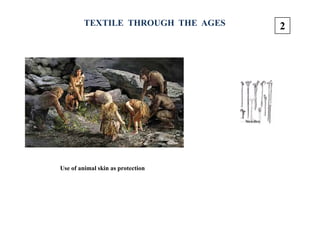textile history ppt.pdf
- 1. TEXTILE THROUGH THE AGES Use of animal skin as protection 2
- 2. MOHENJODARO Cloth draped over the lady shoulders Stone sculpture (dubbed the Priest King by archaeologists) wears an elegant robe with decorative motifs and patterns that are still in use in modern Gujarat, Rajasthan and Sindh. 3
- 3. INDUS VALLEY CIVILIZATION Artifacts/clay seals and terracotta figures give idea of dressing Variety of Headdresses Ornaments 4
- 4. Alexander’s India invasion Cotton processing TEXTILE THROUGH THE AGES 5
- 5. Death Procession of the Buddha (Heads of all the accompanying Retinue are Turbaned Sari Trails the Dominating Central Figure Some Ajanta Cap Styles A Congregation from Ajanta, No Two Figures Wear the Same Clothes TEXTILE THROUGH THE AGES 6
- 6. VEDIC PERIOD Yogi wearing Dhoti (Vasa) & Sacred thread Paridhana Mekhala 7
- 7. MAURYAN PERIOD Statues of Yakshis; the female epitome of fertility Antariya and Uttariya 8
- 8. GUPTA PERIOD Ancient form of Churidar Stitched Garments 9
- 10. Amrapali a courtesan meet Gautam Buddha Hiranya (cloth from gold) & Universe TEXTILE THROUGH THE AGES 11
- 11. Lord Vishnu (Tantuvardan or Weaver) Saint Kabir TEXTILE THROUGH THE AGES 12
- 12. KABIR 13
- 13. VARANASI 14
- 14. From Cradle to Coffin, One cannot live without Textiles 15
- 15. TEXTILE TRADE 16
- 16. TEXTILE TRADE 17
- 17. Map for illustration purpose only 18
- 18. DACCA MUSLIN A woman clad in fine Bengali muslin, 18th-century Princess Zeb-un-Nisa, Aurangzeb’s daughter Egyptian Mummies wrapped in Muslin 19
- 19. DACCA MUSLIN 20
- 20. CHARKHA Cotton spinning with Takli 21
- 21. CHARKHA Single Spindle Charkha 2 Spindle Charkha 4 Spindle Solar Charkha 22
- 22. KHADI… Signage kept at Kochi with an appeal to the citizens to use Khadi/ handloom based wear 23
- 23. HANDLOOMS Handloom Clusters Handloom Cluster wise Product 24
- 25. POST INDEPENDENCE ..… Power transmission by Overhead shafts and belts 26
- 26. MILLS TO MALLS 27
- 27. INDIA’S TEXTILE INDUSTRY  Industrial Production Share : 12% (Source: CSO-IIP)  Exports Share : 12% (US$ 38.52 billion) (Source: DGCIS)  Share in the nation’s GDP is 4%. (Source: Annual report)  Second largest employer after agriculture: 45 Mn (direct) & 60 million (indirect)  Share in global Textile trade : 5.8%  Clothing Trade : 3.7% (Source: WTO-2014) Textile Basics 28
- 28. INDIA’S STRENGTHS IN TEXTILES India is :  Largest producer of Cotton and is the second largest exporter & consumer of cotton in the world.  Cotton production in the country is over 300 lakh bales per year  In India cotton and man-made fibre mix has ratio of 70: 30 vis-à-vis Globally where its just the opposite at 30:70.  A recent initiative by Hon’ble Minister on Twitter under the hashtag #CottonIsCool, was liked by one and all.  Largest producer of Jute  Second largest producer of Silk and Cellulosic fibre/yarn  Second largest Synthetic Fibre producing country 29
- 29. India’s Strength in Capacities 2nd largest manufacturing capacity in spinning • Spindles: 45 Million, Largest fabric manufacturing capacity • Powerlooms: 2.48 Million • Handlooms: 2.14 Million Large number of skilled manpower and technocrats 30
- 30. Technical Textiles Agrotech Geotech Indutech Meditech Buildtech Sportech Mobiltech Protech Important application areas of Technical Textiles 31
- 31. Olden day Technical Textiles Jute sacks Ropes Cloth for filtration Bandage Cloth Photography Backdrop Fabric Fishing Net Postal Envelop with fabric Book Binding cloth Mosquito Net 32
- 32. Olden day Technical Textiles Wright Brothers: Muslin as a covering for wings and control surfaces Sail Cloth Canvas shoes Kite flying Rakhi :Threads of Bonds 33
- 33. INDIA VS. EMERGING ASIA ON GLOBAL COMPETITIVENESS INDEX Source: http://www.livemint.com/Politics/j8krrE4SIEtv5gngbu7OJM/India-jumps-16-places-in-WEF-ranking-but-hurdles-remain.html 34
- 34. INDIA IS CATEGORISED AS A FACTOR-DRIVEN ECONOMY Source: http://www.livemint.com/Politics/j8krrE4SIEtv5gngbu7OJM/India-jumps-16-places-in-WEF-ranking-but-hurdles-remain.html 35
- 35. • Emerging Economics are typically characterized by high unemployment, low per capita income, low educated workforce, low investment and low foreign exchange reserves. • Textile and apparel manufacturing sector is a low technology sector with low capital investment but high employment potential for unskilled labour and high export potential. MIGRATION OF TEXTILE & CLOTHING MANUFACTURING INDUSTRY 36
- 36. SOME IMPRESSION IN STAMPS 37





































